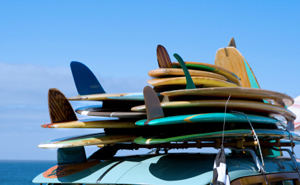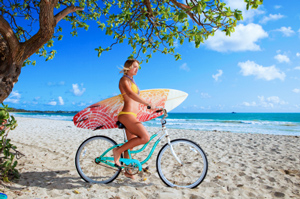Types of Surfboards
Surfboards have undergone enormous changes since ancient Hawaiians first made them out of local tree wood; each new era brings new materials, theories, and designs. Even in the last ten years, surfboard design has taken significant new turns, most notably with the use of alternative epoxy materials and shorter design templates.

However, even as surfboards continually evolve, a few types of boards remain constant, a sort of base from which all the twists and tweaks can take shape. The longboard, shortboard, fish, and hybrid have all stood the test of time to emerge as the standard classes of modern surfboards.
Longboard
The original. Timeless, classic, and great for surfing in a variety of conditions, longboards have been used since the sixth century and continue to hold a place in the modern surfboard quiver.
History
In the early part of the twentieth century, Hawaiian swimming and surfing legend Duke Kahanamoku took his longboard to the mainland United States, as well as Australia, and introduced the rest of the world to surfing. Longboarding took hold along the California coast, and by the 1950s, places like Malibu, Rincon and San Diego’s Windansea saw the dawn of a new age of surfing. Longboards began to take on sleeker shapes, and new materials such as polyurethane foam and fiberglass transformed the balsa wood boards of yesterday into the lightweight boards we use today.
Shapers
Legendary shapers of longboarding’s golden era include Tom Blake, who designed the first hollow surfboard in 1926, a board that went on to be mass-produced throughout the 1930s. Blake also pioneered the use of fins, attaching a “fixed fin” to the bottom of his boards starting in 1935.
Pete Peterson is credited with building the first fiberglass board in 1946, which featured a redwood stringer running down the center of the board. Joe Quigg, Matt Kivlin, and Bob Simmons refined the fiberglass technology further, introducing new hydrodynamic theories and new shapes to go with them.
In the mid 1950s, Californian Dale Velzy began the first line of commercial, mass-produced surfboards as he struggled to meet the demand for his popular “pig” design. Boards of the era were typically between 9 and 11 feet long, and featured a convex bottom known as the “displacement hull”.
The Contemporary Longboard
Modern longboards are dramatically different than their predecessors because they feature design characteristics first pioneered during the “shortboard revolution” of the 1960s and 1970s. Sharper rails, relatively flatter bottoms, and tri-fin designs have assimilated with the classic longboard shape, creating a high-performance craft that still carries the glide and versatility of older incarnations.
Shortboard
The modern shortboard is the preferred craft for today’s high-performance surfer. It allows quick, powerful turns and tight maneuverability. The limits of the sport itself are under constant re-evaluation thanks to its design.
History
The shortboard revolution officially began in 1966 at the World Surfing Contest in San Diego, California as Australia’s Nat Young paddled an under seven-foot board into the lineup. Young proceeded to turn the surf world upside down with quick, aggressive turns in the pocket, forever altering the conceptual core of what high-performance surfing should look like.
The events that lead up to Young’s historic outing in 1966 came from an unlikely source: kneeboarding. It makes sense in retrospect, but at the time, the eccentric Californian kneeboarder George Greenough and his surfing was oddly unconventional, though few could argue Greenough’s skill and inventiveness when it came to riding waves. Inspired by Greenough’s relatively short board designs and radical approach to surfing, Australian shaper Bob McTavish began to experiment with shorter templates, eventually shaping the board Young would surf at the ’66 contest.
McTavish’s design was slow to catch on at first, as the longboarding surfing style stubbornly held on to its roots. But by 1967, further refinements on the shortboard design and a new crop of young surfers in Hawaii, California, and Australia caused the transition to fully actualize. Surfers like Barry Kanaiaupuni, Wayne Lynch, and Gerry Lopez took the new shortboards to unprecedented new heights, riding deep in the tube and performing maneuvers never before seen.

In 1981, Australian Simon Anderson experimented with a new three-fin design, also known as the “Thruster.” The three fins increased the board’s stability in large surf dramatically, a point he proved by winning the prestigious Bells Beach surf contest in 1981 on one of his new boards.
The Thruster, and shortboards in general, became the new standard, rendering the longboard an heirloom of the past.
Fish
Strictly speaking, the fish design is a short, wide, swallow tail twin-fin, no more than six feet in length and at least 21 inches wide. Popularized in the ‘70s as a new alternative to the single fin shortboard, the fish continues to hold value to surfers because of its single greatest attribute: speed.
History
Although similar models were reportedly designed prior to Steve Lis’ rendition, Lis is credited with combining the split, or swallow tail, with the twin-fin design in 1972, resulting in the fish. The board’s wide outline and flat, low rocker bottom gave it ample speed in all types of waves, though most agree that it struggles somewhat in larger surf.
Since Lis’ 1972 prototype, countless renditions of the fish have been produced with varied success. In the mid-1990s, shapers began to design small-wave boards by adding fish-like attributes to standard shortboards. By the mid-2000s, seemingly every shaper produced some kind of fish-inspired design, although the true Lis fish has been somewhat relegated to retro enthusiasts.
Hybrid
Hybrids are the result of a rising demand for surfboards that are easily accessible to the average surfer. They combine the paddling power of a longboard with the maneuverability of the shortboard, and are usually about seven to eight feet long and quite thick. Shapes vary from standard longboard outlines to oversized shortboards. Although hybrids are anything but sexy, they are a practical surfboard choice for beginner and intermediate surfers.
Honorable Mentions
- Gun: Long, narrow surfboard used to catch and surf big waves. Lengths range from seven feet (mini-gun) to over 12 feet.
- Bonzer: Surfboard designed with one large center fin and either two or four small side fins.
- Mini-mal: Essentially the same as a hybrid, with design traits taken from both the longboard and shortboard.
- Single-fin: Surfboard with one center fin; can refer to a long or short board.
- Quad: Surfboard with four fins.
- Kneeboard: Surfboard meant to be surfed in the prone position. Usually resembles a fish.
There’s little doubt that future wave-riders will craft any number of never-before-seen surfboards, combining new shapes and sizes to create boards with only a slight resemblance to earlier models. But these new surfboards will invariably share a common thread with their Hawaiian predecessors, and with the categorical designs of the longboard, shortboard, fish, and hybrid.
